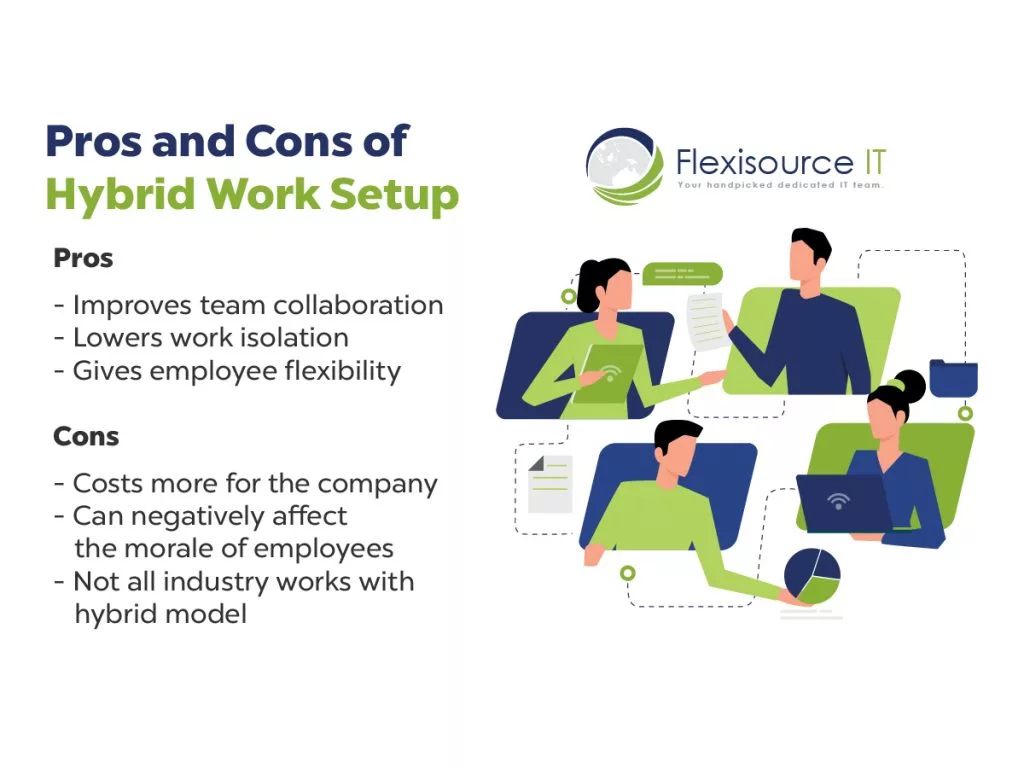With most of the world’s population getting their COVID-19 vaccines, many companies are switching from remote working to hybrid or onsite work setups. Governments are also encouraging companies to mandate their workers to work in the office to pump up the economy.
Still, working from home or in an office is a personal preference. Some people prefer the flexibility and freedom of working from home (WFH). In contrast, others crave the social interaction of an office. This is probably due to the benefits and drawbacks each setup contains. But what is better for employees and the company?
In this article, we will look at the pros and cons of each setup to make a more informed decision on which one is right for you for Hybrid vs Work from home.
What is Hybrid Working?
Hybrid working is a new trend in the workforce that combines remote work and office work. It can be done from home, from the office, or from any other place connected to the internet. It’s also known as hot desking.
The idea behind the hybrid work model is that people can manage their time better when they are not stuck in a single location. It can also help productivity and creativity because you have access to different environments that offer other things.

Benefits of Hybrid Work Setup
A hybrid work arrangement can appeal to many employees for the advantages and flexibility. While the WFH setup allows employees to work in their own homes, the hybrid design gives people who want to go out and interact. Likewise, here are some of the Hybrid working advantages
1. Improves team collaboration
At the pandemic’s start, many companies find remote workers harder than onsite. Many companies and team leaders find it challenging to communicate and collaborate with their employees and team members. But as the pandemic lasted, a lot found ways to communicate through modern tools and software.
While these tools enabled the organization to seamlessly collaborate. Some matters, however, could only perfectly be done face to face, such as team building, brainstorming, idea mapping, etc. As such, many companies are embracing the idea of hybrid work.
This is where people have a mix of working from home and in the office. It has helped a hybrid vs work from home improve team collaboration and employee satisfaction.
2. Lowers work isolation
Not all employees enjoy working remotely. Some may feel isolated or alone with remote work since human interaction is limited compared to face-to-face working.
Managing your hybrid workforce can lower work isolation by providing a sense of community with other employees who are also working remotely. It also creates a more flexible schedule to choose when they want to work and how much time they want to spend at the office. Likewise, it provides them a choice and opportunity to interact with their colleagues and work together if they feel isolated.
3. Gives employee flexibility
Remote working has allowed employers to avoid commuting and focus on their tasks without distractions. However, hybrid work will enable people to work from home or remotely, depending on their preference. This can help employees better manage their time between accomplishing work and personal tasks.
Drawbacks of Hybrid Setup
Despite its advantages, hybrid vs. work from home can have one drawback. It can be challenging to some individuals, affecting their overall work performance. Here are some disadvantages of hybrid working you should look out for:
1. Costs more for the company
Switching to a hybrid setup can be costly for many businesses. Since the pandemic, many companies to let go of their office space, equipment, etc., and switched to smaller ones. If a company changes to a hybrid work setup, they need to invest in these needs again.
In addition, since some employees will be working in the office, it would generate more costs such as electricity bills, food, allowance, etc.
The hybrid setup is not also that friendly with employees. Remote working enabled employees to save commuting costs. However, a hybrid work model will force them to spend more commuting, food, etc.
2. Can affect negatively affect the morale of employees
As mentioned earlier, not all employees are happy to return to the office. Some prefer to have the freedom to work from home. They may feel stressed about finding accommodation near the workplace or commuting to work. This can lead to burnout and decreased productivity.
Thus, it’s essential to ask your employees before mandating them to work in the office. In addition, there are ways to keep remote employees engaged that do not require them to appear in the office.
3. Not all industry works with the hybrid model
While the hybrid work model is great for some companies, it is not suitable for all industries. Some industries like healthcare, manufacturing, and retails needs to have a face-to-face work setup to do their work. On the other hand, jobs relating to IT, writing, and research are best done at home. Thus, before switching to the hybrid model, make sure that it fits well, as it can do more damage than good.
What is Work from Home Setup?
Working from home is very different from an onsite or hybrid setup. The work-from-home work setup allows the employee to work from their home office. This arrangement may be beneficial to the company and the employee. The company may save money on office space, while the employee can save money on commuting costs and childcare.
Some workers prefer to work from home because they want more flexibility in their day-to-day schedules. Others like to work at home because of health reasons, such as allergies or chronic illnesses that make it challenging to be around others all day.

Pros of Work from Home Setup
Remote working has many benefits. It can help employees be more productive, reduce the costs of office space and equipment costs, and improve employee satisfaction. Here are some advantages of work from home setup.
1. Reduced commute time or less time on the road
Remote working has become increasingly popular over the years as more people choose to telecommute or stay at home instead of commuting to an office every day. Employees often move near their workplace for convenience, as longer commutes can cause exhaustion and stress. It can lead to dissatisfaction and burnout. In addition, it can lead to unproductivity or resignation.
Letting your employees work from home will save them from commuting.
2. Greater productivity
A study from Stanford University found that remote workers were 13% more productive than their counterparts in the office. This is because they are not distracted by coworkers or other people in the office. Remote workers also can work when they are most productive, which leads to better results.
3. Fewer costs and more money saved
Another benefit of remote working vs. hybrid working is that it can reduce the costs of office space and equipment for companies when onboarding remote developers. This is because there will be less need for desks, chairs, printers, etc. The company will also save money on things like utilities and maintenance costs for buildings and heating or cooling bills in warmer climates.
Cons of Work from Home Setup
Like the hybrid model, work from home setup also comes with many challenges for both the company and employee. Here are some disadvantages of work from home setup.
1. Lack of teamwork
Employees who work from home have less access to their colleagues and managers for support. This situation can cause gaps in their relationship or cause miscommunication between them. It can also lead to a decrease in morale and motivation.
2. Lack of motivation
As mentioned, work from home setup can cause the feeling of isolation. As such, employees may lack the motivation to do their tasks. Furthermore, this lack of motivation can lead to higher turnover rates and lower productivity levels for companies that offer remote working options for their employees.
3. More security concerns
The workplace is no longer confined to a single location. A study from the University of Sydney found that remote working can lead to more security concerns than traditional office work. A company’s physical office space was enough for security purposes in the past. Nowadays, companies are using more and more remote workers. They must put in extra effort to ensure that they are not compromising on security.
Remote workers need a secure VPN connection and strong passwords to protect themselves from cyber-attacks.
Choosing between Hybrid vs. Work from home Setup
In summary, hybrid vs. work from home offers its own benefits and drawbacks that can affect employees’ performance and resources. A hybrid work arrangement can help employees communicate and collaborate better but can cause financial instability and stress to employees. On the other hand, work from home arrangements can help both employees and the company save resources but at the same time comes with security risks.
It is best to carefully plan and study these arrangements before implementing them. Just make sure that you consider employees’ physical and mental health and preferences before considering a hybrid work arrangements.
By analysing these factors and impacts, you will craft your perfect work arrangement. Make sure to seek help from recruitment or outsourcing firms like Flexisource IT. Contact us now!





